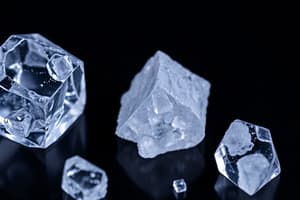Podcast
Questions and Answers
What characteristic distinguishes solids from liquids and gases?
What characteristic distinguishes solids from liquids and gases?
- Solids are composed of molecules that are loosely packed.
- Solids have variable shape and volume.
- Solids have a definite shape and volume. (correct)
- Solids exhibit high thermal energy.
What type of solid has particles arranged in a regular and repeating geometric arrangement?
What type of solid has particles arranged in a regular and repeating geometric arrangement?
- Polymeric solid
- Composite solid
- Crystalline solid (correct)
- Amorphous solid
Which of the following describes the atomic arrangement in amorphous solids?
Which of the following describes the atomic arrangement in amorphous solids?
- Completely disordered
- Geometric and predictable patterns
- Random arrangements without a long-range order (correct)
- Regular and orderly
In terms of thermal energy, which statement is true regarding solids?
In terms of thermal energy, which statement is true regarding solids?
What is the primary force that keeps the particles in a solid tightly packed together?
What is the primary force that keeps the particles in a solid tightly packed together?
Which of the following is NOT an example of a crystalline solid?
Which of the following is NOT an example of a crystalline solid?
What is the term used for the arrangement pattern that forms a cubic structure?
What is the term used for the arrangement pattern that forms a cubic structure?
What happens to atoms in a solid at low temperatures?
What happens to atoms in a solid at low temperatures?
What stacking sequence is characteristic of hexagonal-close packing (HCP)?
What stacking sequence is characteristic of hexagonal-close packing (HCP)?
In a body-centered cubic (BCC) lattice, where is the additional atom located?
In a body-centered cubic (BCC) lattice, where is the additional atom located?
What type of bond is formed with an electronegativity difference greater than 2.0?
What type of bond is formed with an electronegativity difference greater than 2.0?
Which type of intermolecular force is the weakest?
Which type of intermolecular force is the weakest?
What kind of molecules exhibit dipole-dipole intermolecular forces?
What kind of molecules exhibit dipole-dipole intermolecular forces?
Hydrogen bonding occurs between molecules that contain which elements?
Hydrogen bonding occurs between molecules that contain which elements?
What is the defined range for a polar covalent bond based on electronegativity difference?
What is the defined range for a polar covalent bond based on electronegativity difference?
Which type of intermolecular force has a stronger effect on the physical properties of solids?
Which type of intermolecular force has a stronger effect on the physical properties of solids?
Study Notes
Course Overview
- Course titled "Chemistry for Engineers" focuses on the intersection of chemistry and engineering.
- Key areas covered: Chemistry of Engineering Materials, Energy and Chemistry, Electrochemistry, Nuclear Chemistry, Chemistry of the Environment.
States of Matter
- Matter exists in different states: solids, liquids, and gases with distinct properties.
- Solids have a definite shape and volume, with tightly packed atoms and strong intermolecular forces.
Properties of Solids
- Low thermal energy results in less movement of particles, contributing to the strength of solids.
- Intermolecular forces are responsible for the condensed state of solids, providing strong attraction between molecules.
Types of Solids
- Crystalline solids have a regular, repeating geometric arrangement of atoms (e.g., table salt).
- Amorphous solids lack a long-range order, resulting in random arrangements (e.g., cotton candy).
Packing Structures
- Cubic-close packing (CCP): layers repeat every three layers (ABCABC), forming a cubic structure.
- Hexagonal-close packing (HCP): layers repeat every two layers (ABAB), forming a hexagonal structure.
Cubic Lattices
- Three main types of cubic lattices:
- Simple cubic crystal (SCC): atoms at cube corners.
- Body-centered cubic crystal (BCC): additional atom in the cube center.
- Face-centered cubic crystal (FCC): atoms on each face of the cube.
Intramolecular vs Intermolecular Forces
- Intramolecular forces are the forces holding atoms together within a molecule.
- Electronegativity differences determine bond polarity, influencing the nature of the chemical bond:
- Nonpolar covalent bond: electronegativity difference < 0.5
- Polar covalent bond: electronegativity difference 0.5 - 2.0
- Ionic bond: electronegativity difference > 2.0
Intermolecular Forces (IMFs)
- IMFs influence the structure and properties of solids significantly.
- Types of IMFs:
- Dispersion Forces (London Dispersion Forces): weakest due to short-lived dipoles, present in all molecules.
- Dipole-dipole Forces: occur in molecules with permanent dipoles, stronger than dispersion forces but weaker than hydrogen bonding.
- Hydrogen Bonding: strongest IMF, occurs between molecules with H covalently bonded to F, O, or N due to high electronegativity differences.
Studying That Suits You
Use AI to generate personalized quizzes and flashcards to suit your learning preferences.
Related Documents
Description
This quiz focuses on the different states of matter in the context of engineering chemistry. It explores the properties of solids, their types, and packing structures. Test your understanding of how these principles apply to engineering materials and processes.




